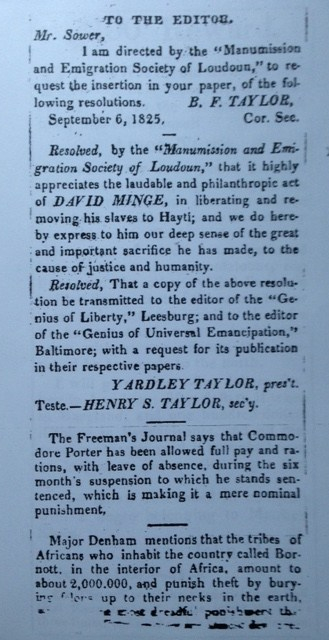The Library of Virginia, in their Out of the Box archives, has a series of articles about the anti-slavery and abolitionist societies which spread into southern states from northern states’ origins.
A short history of the Virginia Abolitionist Society can be found here.
We know from public writing – one example is the letter below – that Yardley Taylor and brothers Benjamin and Henry were early supporters of the Manumission and Emigration Society. The nation’s various Manumission and Emigration Societies paid expenses for freed enslaved men and women to leave America and emigrate to Africa or Haiti. Emigration was a popular idea during early abolitionist efforts. Even noted abolitionists such as Frederick Douglass thought freed former enslaved blacks, or freemen and women, would have to leave racist America in order to have equality and fair opportunities.

Eventually it became apparent that emigrating newly freed blacks to Liberia was both financially impractical and unpopular. Most freed blacks rightly felt there was no reason they should have to leave the United States. Many anti-slavery activists, including the Lincoln, Virginia based Taylor brothers, moved away from emigration/colonization goals. They continued to focus on manumission efforts, however, as well as ending slavery across all states and territories. Yardley Taylor devoted his life to the effort. Nest of Abolitionists has information on Yardley Taylor, and also on his brother, Henry Taylor.



0 comments on “Nest of Abolitionists and the 1820’s Manumission and Emigration movement”